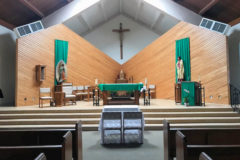Gospel of John, chapter 10: 1-10
The church where I worshiped for a large part of my young life sits balanced atop a rather steep hill. From this vantage point, you can view the entire town of Letterkenny as it zig zags its way down the hill from all sides. But, perhaps the most captivating sight from this altitude was the beautiful patch-work of sheep-farms and meadow-lands that rose up windingly from the bottom of the hill, encircling the church all around. Regretfully, today that pastoral scene has been changed as a result of housing projects scattered all over the landscape. Thus, I have come to appreciate what being a shepherd means and why Jesus chose the relationship between a shepherd and his sheep to describe His relationship with His people.
In today’s gospel, Jesus uses the image of the shepherd to describe His style of leadership. He draws on local understanding of how sheep were herded at that time. For example, unlike modern shepherds, the Semitic shepherd led his sheep; he did not drive them. Likewise, the ancient shepherd’s pen was formed of simple brambles and a rope. The shepherd himself would serve as the closure to the pen; that is, he was the sheep-gate. He would also sit and guard his sheep. The sense of identity between the good shepherd and his sheep was so intimate that the shepherd could gather them simply by voice; the sheep would respond to his voice and follow him.
Uniquely, Jesus identifies himself with the shepherd and with the gate. He is both our guide and protector. As guide, He leads us through hardships and brings us to salvation. As protector, He offers us security and comfort along the way. Jesus is telling us that our destiny as Christians is inseparably linked to Him. Our safety and guidance depend on our faith in Jesus as both shepherd and sheep gate.
Whoever enters through Him will be saved.
Fr. Hugh Duffy
* * * DO NOT MISS TOMORROW’S BLOG ON W A R * * *







Recent Comments